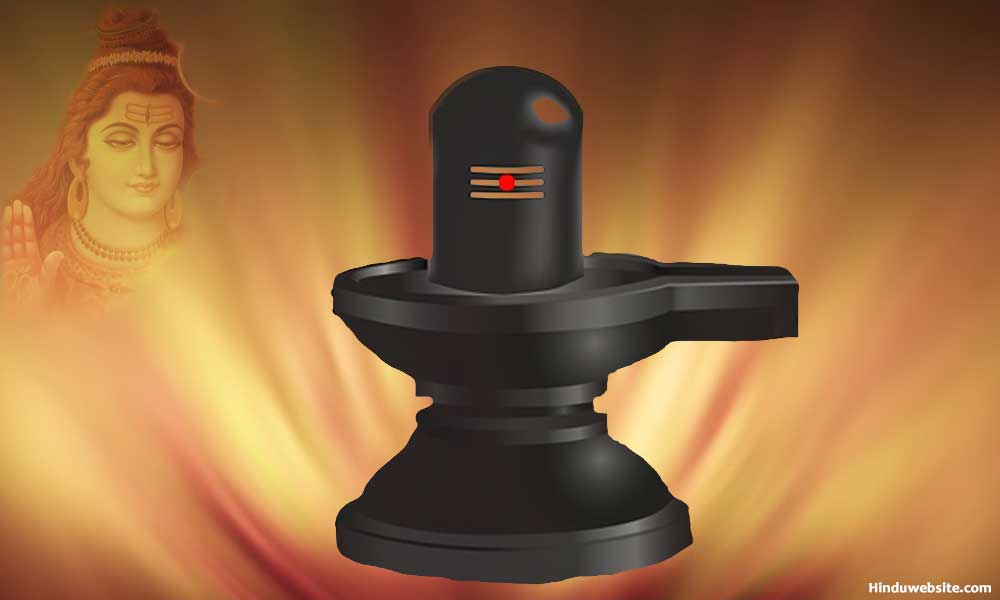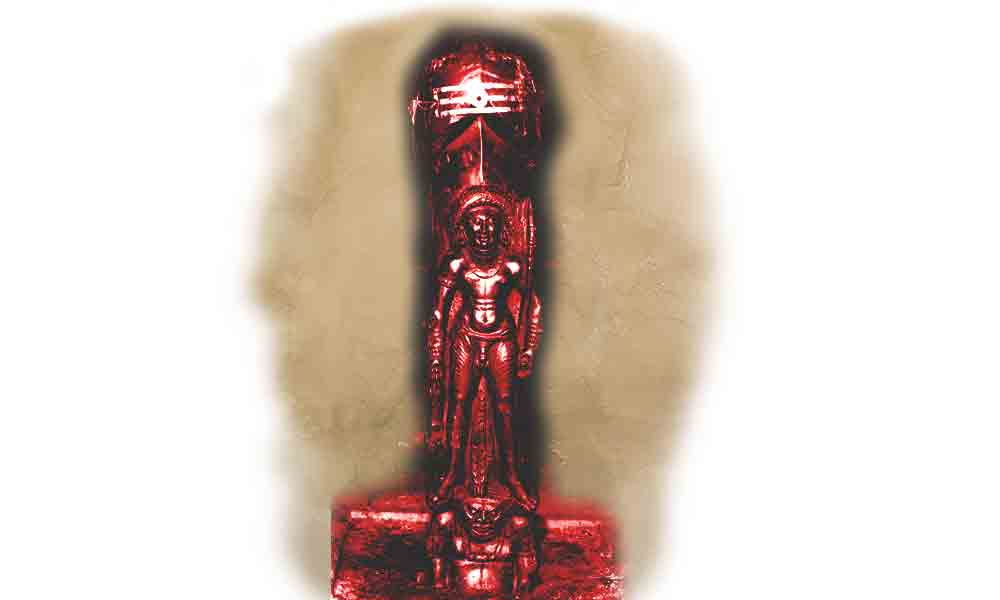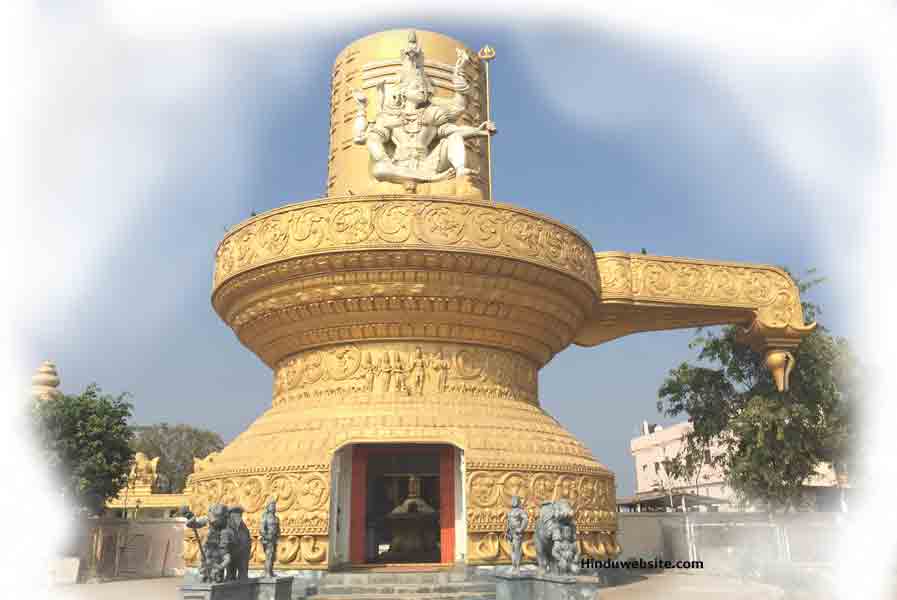
The Symbolism of Shiva Lingam

Shiva Lingam is the subtle body of Shiva as Isvara with Shakti as his dynamic force.
Shivaling (of Shivalingam, also Shiva Lingam) represents Shiva (and Shakti) in all conceivable forms from the highest to the lowest. "Shiv" means pure and auspicious. "Lingam" means the subtle body. We have stated elsewhere that Shiva is not a mere tamasic god. His role as destroyer of the world is one of his aspects or manifestations only. Shiva is the purest of all deities. Hence, his color is neither blue nor black, but white, which denotes his purity or sattvic nature.
Since Shiva Lingam represents the purity of Shiva, his manifestation as Isvara and his inseparable union with Shakti, his dynamic aspect,, its worship (lingarchana) is the most popular form of worship in Shaivism as well as in mainstream Hinduism. In some sects, the Lingam is also used as an amulet and worn on the body. The very presence of Shiva Lingam is said to have beneficial effects upon everyone in the vicinity. By worshipping it, one is cleansed of all past sins. The Tantric texts contain detailed information on how to worship the Lingam for best results.
History
The history of Shiva Lingam goes back to prehistoric times. Many objects that are similar to it were found in the excavations at various Indus sites. (However, some historians do not agree that they represent the later day Shiva Lingams). Thousands of temples all over India are exclusively dedicated to the worship of Shiva in this form. Of them, some are called Jyotirlingas (lingams infused with light) and considered the most sacred.
The Jyotirlinga temples as well as the Shakti temples are scattered all over India. Each has its own mystic, spiritual and historic significance. Because of their sanctity and historicity, each year they attract millions of devotees from faraway places. Most of them are located on the banks of sacred rivers or near water bodies or high in the Himalayas, signifying Shiva’s connection to water, snow, healing and cleansing. The oldest Shiva Lingam to date is found in the Parashurameshwara temple, near Tirupathi in Andhra Pradesh which is believed to be in existence since the 3rd Century BC.
 Shiva Lingam at Parashurameshwara temple, near Tirupathi in Andhra
Pradesh
Shiva Lingam at Parashurameshwara temple, near Tirupathi in Andhra
Pradesh
Types of Shiva Lingams
Shiva Lingams are of different types, depending upon the material with which they are made. The Pancha Bhuta Lingams, each of which is made of one of the five elements (earth, sky, water, fire and air) are located at Kanchi, Chidambaram, Tirchinapalli, Tiruvannamalai, and Sri Kalahasti respectively. They are also often associated with the sun and the moon,. For example, the temple at Konark, near Jagannath Puri temple is known as Surya Lingam and the one in Bangladesh near Chittagong is known as the Chandra lingam.
The Lingams may be made of wood, stone, precious stones, gold, silver, alloys (dhatus), glass, plastic, earth, rice, flour and clay. Many round and polished stones which are naturally found in the river beds of some sacred rivers such as the Narmada are also used as Shiva Lingams. Shiva Lingams are often found by chance. The places where they are found are usually considered sacred. Some of them may be ancient historic sites. Many temples were raised in the past where Shiva Lingams were unearthed during excavations, digging or plowing.
The Mahaparinirvana Tantra declares that installing Shiva Lingam in a temple or in a house in itself is highly beneficial, which is equal to performing 10,000 horse sacrifices or digging a water tank in an arid region. Those who engage in it are cleansed of all sins. All the deities, including Brahma and Vishnu reside in the area where it is installed. Those who live in its vicinity are also purged of all sins which they committed elsewhere.
However, devotees are advised not to take liberties with Shiva Lingams. They are expected to live virtuous and pious lives when they are near Shiva Lingams, or when they install them in their houses. Because of the sanctity attached to them, they are not meant to be used for ornamental and vain purposes or as a show off. It is said that while they cleanse the worshippers of their past sins, any sins which are committed in the vicinity of a Shiva Lingam, be it a temple or a house, stick to the sinners and strike them with the force of a thunderbolt. Hence, one of the popular beliefs is that one should not keep a Shiva Lingam in the house unless one wants to worship it according to established procedures and lead a virtuous life. Another belief is that one should not worship a broken Shiva Lingam or a broken image of Shiva.
Symbolism
Shiva Lingam has a lot of symbolic significance. As described before, the Lingam is the symbolic representation of Shiva in his subtle and formless aspect as Isvara, in association with Prakriti, his dynamic force. The Shiva Lingam represents their eternal and inseparable union, from which manifests everything. Linga in Sanskrit means, subtle. Hence, the literal meaning of Shiva Lingam is the formless, subtle body of Shiva in perfect union with Shakti. As the Bhagavadgita declares, creation happens when Purusha becomes established in Prakriti.
The Shiva Lingam represents that state. Since they are forever united, it represents both the duality and nonduality of existence. Shiva and Shakti are indistinguishable in their purest and highest aspect, but become differentiated in the lower planes of creation to make possible the continuity of life through death and rebirth. The ultimate reality is nondualistic, but the apparent reality is dualistic due to the illusion or delusion caused by the power of Maya or Shakti.
In other words, although Shiva and Shakti outwardly seem to represent different realities, at the highest level they represent but one, ultimate reality. The Shiva Lingam objectifies not only their eternal union but also their unitary aspect, besides affirming the Advaita Vedantic (nondualistic) belief that although Shiva and Shakti seem to be outwardly different, at the subtlest level they are but one. By worshipping it, a devotee simultaneously worships both the deities.
The blessings of both Shiva and Shakti are needed for liberation. Although Shiva’s grace (anugraha) is essential to achieve liberation, the cleansing and preparation is done by Shakti only. Hence, Sri Aurobindo used to advise his followers that one had to propitiate both, but surrender to the Mother and let her do the cleaning. Self-transformation should not be an egoistic effort. It has to happen with divine intervention for which one has to seek divine help. The Shiva Lingams offer us the easiest way to worship them both at the same time and earn their grace.
Since the Shiva Lingam personifies the formless Shiva containing within himself the dynamic Shakti, scholars consider the worship of Shiva Lingam not the same as idol worship. In idol worship you worship the images or idols (murthis) of a deity whereas when you worship the Shiva Lingam, you worship the formless (amurtha) Shiva and Shakti. Hence, worshipping Shiva Lingam is considered superior to any ritual worship in which images and idols are used. The Mahabharata concurs with this opinion. The epics and Puranas state that even divinities such as Rama, Krishna, Parvathi and Ganesha worshipped Lingams to propitiate Shiva.
According to the Shiva Purana, the Shiva Lingam contains in itself the sky and the earth. The upper part represents the heaven or the sky, and the lower one (the base), the earth. Since it is practically difficult for humans to worship the sky and the earth, one can accomplish the same by symbolically worshipping the Shiva Lingam. The Skandapurana states that the Shiva Lingam is eternal and uncreated. It was intact during the end times, and was also witnessed by Brahma and Vishnu in the beginning of creation as preexisting. The Shiva Purana also states that Aum is the heart and soul of the Shiva Lingam (pranavatma), and worshipping it similar to chanting Aum.
The commonest symbolic interpretation of Shiva Lingam is that it represents the union between Shiva and Shakti from the highest plane to the lowest. Everything in the universe, from the highest to the lowest, owes its existence to their union. The lower part (linga vedi) represents Shakti and the upper part (lingam), Shiva. At the subtle level, the upper part represents Shiva as consciousness and the lower one Shiva as Shakti or energy. Together, the Shiva Lingam embodies the union of Purusha and Prakriti as chit-shakti (consciousness infused with energy).
In a living being or embodied soul (jiva), the Shiva Lingam represents the union of Shiv and Shakti as the mind and body or the soul and body or prana and apana or knowledge and ignorance or purity and impurity and so on. The soul is Shiva, and the body is Shakti. The subtle body is Shiva and the gross body is Shakti. Thus, each living being, especially a human being, is a walking and breathing Shiva Lingam. As the round object and the seat of consciousness, the head is Shiva, and as its support or base, the physical body is Shakti.
Is it a phallic symbol?
In popular tradition and public opinion, Shiva Lingam is a reproductive symbol or a symbol of fertility, representing the sexual union between Shiva and Parvathi. The upper part represents the male sexual organ and the lower part, female sexual organ. This interpretation is supported by both archeological and literary evidence. In some of the oldest temples, as shown in the image above, Shiva Lingam are carved in the shape of a penis. However, it would be preposterous to conclude that Shiva Lingam is just a phallic symbol. The symbolism coupled with some of the questionable practices of Tantra have often been used by critics to deride Hinduism. The truth is that the sexual aspect of Shiva Lingam is one of the many interpretations. It is popular because it is easier to understand and perfectly represents the functional and essential aspects of Shiva and Shakti as the husband (pati) and wife (patni)of creation.
Shiva and Shakti are not merely sexual objects. Their union does not produce sexual pleasure only. They are the highest and ultimate realities which are hidden in the whole existence and everything. As the supreme universal deities, they have many gross and subtle aspects. They are inherently and universally present in all. The Shiva Lingam perfectly represents their immense, outward diversity and hidden, inward unity in all aspects of creation. Technically, every object in existence is a Shiva Lingam. It does not have to be round. It does not have to possess life or consciousness. It can be any object or phenomena in which Nature has its presence as matter and energy, with Shiva as the pervasive and supporting reality.
Everything in existence is sacred because everything is Shiva and Shakti or Shiva Lingam. Creation itself is a huge Shiva Lingam, which is made possible by the union of Shiva and Shakti only. Hence, Shiva lingam can be compared to every aspect of creation. For example, you may compare the upper part of Shiva Lingam to the sun, sky, breath (prana), intelligence and mind, while the lower part to the mortal world, elemental world, materiality, gross body, etc.
 Shiva Temple in the shape of a lingam near Vijayawada, A.P.
Shiva Temple in the shape of a lingam near Vijayawada, A.P.
The symbolism of the lower and upper parts of Shiva Lingam is shown in the following table. Some of the interpretations are based upon the author’s intuitive knowledge. You may not find them in any Saiva text or scripture. Further, some Shakta traditions may not accept much of the symbolism which is discussed here, since they hold different beliefs about Shiva and Shakti. For example, some of them regard Shiva as an aspect of Shakti and envision her as the supreme being. They may also look upon her both as pure consciousness and energy combined, and Shiva as a passive witness in a subordinate and insignificant role, serving almost as a pole or a stake in the sacrificial ritual of life. For example, the Yogini-hridaya-tantra extols Shakti thus, “Obeisance to Her who is pure Sachhidananda (being, consciousness and bliss), who as Shakti (power or force) exists in the form of Time and Space and all that is therein, and who is the radiant illuminator in all beings.”
Symbolism
| Upper Part | Lower Part |
|---|---|
| Shiva (God) | Shakti (God power) |
| Nirguna Shiva | Adi Shakti (primal Nature) |
| The sky | The earth |
| Heaven | Earth |
| Higher worlds (lokas) | Lower worlds (talas) |
| Consciousness | Matter or energy |
| Subtle body | Gross body |
| Purusha | Prakriti |
| Pure Consciousness | Purest (suddha) Sattva |
| Upper body | Lower Body |
| Breath | Nadis or breath channels |
| Mind | Ego |
| Knowledge | Perception |
| Intelligence | Intellect (buddhi) |
| Atma (Soul) | Atma Shakti |
| Penis | Vagina |
| Day | Night |
| Light | Darkness |
| Nirguna | Triguna |
| Immortality | Mortality |
| Birth | Death |
| Fetus | Womb |
| Awakening | Practice (Sadhana) |
| Liberation | Bondage |
| Samadhi | Sambhog (sexual union) |
| Speech | Organ of speech |
| Nada (divine sound) | Hearing |
| Sound | Space |
| Aum | Im, Hrim |
| Pure light | Impure light |
| Subject | Object |
| Bliss | Pleasure |
| Sacrificial Fire (Yagagni) | Sacrificial pit (Yajnakund) |
| Reality (sat) | Illusion (Maya) |
| Sruthi | Smriti |
| Dakshinamurthy (World teacher) |
Jangama (Guru) |
| Yogi | Yogini |
| Deva | Devi |
| Silence | Sound |
| Awareness | Ignorance |
| Vidya | Avidya |
| Apara (transcendental) | Para-apara |
| Sarvam (all) | Idam (here) |
| That (asmi) | This (etat) |
| Isvara | Aham |
Suggestions for Further Reading
- Lord Shiva as Isvara, the Manifested Brahman
- Notes on Shiva Lingam
- Symbolism of Hindu Concepts, Gods and Goddesses
- Symbolism and Significance of Vibhuthi in Hinduism
- The Symbolism of Purusha and Prakriti
- The Symbolism of Mahishasura Mardini
- Ganesha As Mahat Tattva, Supreme Intelligence
- Aspects of Lord Shiva
- Nataraja, The Lord of the Cosmic Dance
- Shiva the Unconventional God of Opposites
- The Panchanana Aspects and Forms of Shiva
- History of Shaivism, Lord Shiva in Vedic Literature and Recorded History
- Significance of Lord Shiva
- Tantra and Tantric Rituals of Hinduism and Buddhism
- Mahanirvana Tantra the Tantra of the Great Liberation Chapter Index
- Essays On Dharma
- Esoteric Mystic Hinduism
- Introduction to Hinduism
- Hindu Way of Life
- Essays On Karma
- Hindu Rites and Rituals
- The Origin of The Sanskrit Language
- Symbolism in Hinduism
- Essays on The Upanishads
- Concepts of Hinduism
- Essays on Atman
- Hindu Festivals
- Spiritual Practice
- Right Living
- Yoga of Sorrow
- Happiness
- Mental Health
- Concepts of Buddhism
- General Essays